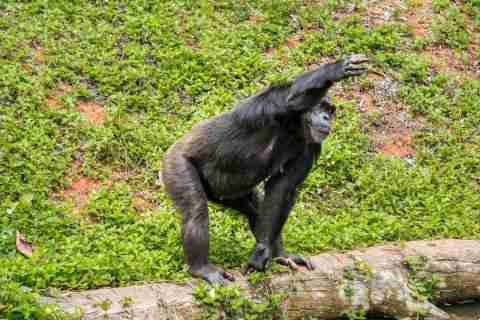Do animals have a preferred paw or limb? Researchers have thought for a long time that dominant right- and left-handed people were the only creatures that displayed this phenomenon. After many studies about handedness in animals, they found that some animals have a preferred paw or limb, at least for specific tasks.
But are there left-handed animals? That’s what we’ll delve into in this article and examine a few specific ones in particular. This includes cats, dogs, and other primates.
Table of Contents
Can Animals Be Left or Right Handed?
It’s interesting to note here that handedness in animals is not limited to primates. Just like humans, many animals are also left-handed or ambidextrous. Dogs are known to be right-pawed or left-pawed, and we can see this preference as early as when they’re puppies. Cats are not as easily categorized, but they can be right-pawed or left-pawed as well. Polar bears used to be known as being left-handed, but further studies have shown they are more ambidextrous and use either paw for the task at hand.
Handedness in animals may not be as dominant as it is in humans, but that doesn’t mean there are no left-handed animals at all. In fact, it is a phenomenon that can be seen in a variety of species. So, the next time you’re petting your cat or playing with your dog, note which paw they seem to prefer and see if you can spot any left-handed behaviors yourself.
Handedness in Animals
Interestingly, this trait seems to have evolved independently in many species. There are several theories about why this might be the case. Some researchers believe that being left-handed offers certain advantages, such as making it easier to sneak up on prey. Others believe it might be a side-effect of genetic mutations. Regardless of the reason, it’s clear that favoring one side of the body or one paw is quite common in the animal kingdom.
Chirality (also known as handedness or laterality) is a human trait characterized by an uneven distribution of fine motor ability between the left and right hands. Because the brain is divided into two parts, tasks are automatically divided between the two sides of the body. A person who is more dexterous with their right hand is referred to as right-handed, although he or she can learn to use their left hand with equal dexterity. In the same way, someone who is more dexterous with their left is referred to as left-handed. In the study of face asymmetry, chirality is also seen.
Chirality can be seen in many animals as well, including cats and dogs. Chirality is important to study in both humans and animals because we can trace the preference of one hand over the other back to genetic mutations. This is the only way that scientists will be able to determine the cause of handedness and why it occurs. Chirality can be seen in cats and dogs, but scientists don’t know why this is.
Handedness isn’t even exclusive to those with limbs or paws. Turtles show a preference for their right hind flipper to protect their eggs after they’ve been laid. Does this mean that these creatures are left footed? Invertebrates like crabs prefer to use their right claws to crack shells.
Even an investigation of the octopus, a creature with 8 arms/hands, showed that the octopuses showed a definite favorite for one arm to go through a maze they put it through for a reward. This shows that no matter how many limbs something may have, there is the possibility of handedness.
We can find other examples in stick insects, sea cucumbers, and some spiders. In stick insects, they use their left and right legs for different purposes. They typically use one leg for walking, while they use the other leg for holding onto objects.
Sea cucumbers have a unique way of swimming that requires them to use their tentacles asymmetrically. One side of their body will pulsate to create a wave that propels them forward.
Spiders use their front two legs for hunting, while they use the back four for walking. They also use the front two legs for spinning webs.
Are Chimps Right Handed?

Researchers have found that chimpanzees are often right-handed for throwing or picking things to put in their mouths. However, it is not completely certain whether this preference applies to other activities, like gathering food or cleaning themselves. Chimps seem to be about 65 to 70% right-pawed.
Are Dogs Right or Left Handed?

They say dogs are a lot like people and it turns out they’re not wrong. Researchers have found that there’s some science behind why we love our pups so much!
Just as with human beings who prefer using their right hand over the left, with dogs, biologists noted a slight asymmetry between canine paw use when observed during food retrieval tasks during research on animal behavior. When some food was placed inside the end of a tube that’s just wide enough for a dog’s paw, there was a population-level right-paw preference in both male and female dogs (60.7 percent female and 56.1 percent male). Unlike in humans, this split in preference is a lot higher because only about 10-15% of humans show a preference for the left hand.
Like in humans, the proportion of dogs exhibiting a right-paw preference was substantially larger in females than males. Elderly dogs also had a larger predilection for the right paw than younger canines. Scientists concluded that the effect of sex on handedness may be regulated by sex hormones, whereas age variations may reflect the formation and maintenance of handedness in dog populations.
So while most people use a right handshake and scouts use a left handshake, dogs choose a paw that feels more comfortable.
In terms of where dogs fall in line with other animals, it’s not that uncommon to see left-handedness in the animal kingdom. In fact, there are some species where being left-pawed is more common than right. Some of these animals include cats, horses, cows, and polar bears. However, scientists have yet to determine why this is the case.
Do Cats Have a Dominant Paw?

Just like dogs and other animals, cats also show a preference for one paw or the other. However, around 25% of cats seem to prefer using their paws equally while 75% of cats showed a preference for either the left or right paw.
Cats can also use their paws ambidextrously. This means that a cat’s dominant paw can change over time. So, if you have a cat that seems to use its other paw more often than the dominant one, don’t worry. This isn’t a cause for concern and this behavior will probably change over time.
Cats also show a preference for using either their left or right paws while playing with toys. It makes sense since there are a few sports humans play that aren’t convenient for lefties. So, if you have a cat that prefers one paw over the other while playing, it’s likely that this is their dominant paw.
While scientists don’t know for sure why cats show a preference for one paw over the other, there are a few theories. One theory is that the dominant paw helps cats to be better hunters. Another theory is that left-handedness in cats is because of genetic mutations.
There are also some studies that show the age of a cat can affect which paw is their dominant one. Younger cats tend to use either both paws equally or favor their left paw over the right more often than older cats do. This means that, most likely, they will pass this trait down from generation to generation in cats.
Are Kangaroos Left Handed?

In a new study, scientists have found that left-handedness is common in kangaroos. It turns out that this is true for eastern grey and red kangaroos, and red-necked wallabies. This confirms that we are not the only ones to have a handedness – other animals do too. Scientists believe this happens from parallel evolution.
Parallel evolution occurs when two species gain similar traits in response to their environment. This can happen when the two species live in the same area and evolve independently to be able to survive in that area. Or this can happen when one species migrates to a new habitat and lives alongside an already present species and they both develop adaptations to survive in this new area.
There are several theories about how handedness evolved over time – including predator-based pressure or environmental factors. However, scientists could not determine which one of these theories is correct.
For kangaroos and their limb preference, scientists believe the species evolved independently. This means that handedness in kangaroos may have evolved to help them with their feeding habits, propping themselves up, and other behaviors. This is what they suspect to be because of laterality.
Laterality is the preferred use of either the left or right side of the body and occurs in both humans and animals. Laterality in kangaroos has been observed when grooming themselves, gripping with their paws, or even propping themselves up off the ground.
Are Polar Bears Left Handed?

Polar bears used to be thought of as being dominantly left-handed. However, it’s been found that instead, they are ambidextrous. This means that they use both their left and right paws equally. It has been reported that nearly all polar bears are left-handed or left-pawed. But it is not true, because they use either paw for different jobs.
We know this because different scientists have observed polar bears and they don’t prefer a hand. Even though they live in a challenging climate, the scientific community has been watching these magnificent creatures for many years and found that the tale spun about polar bears being only left-handed simply isn’t true.
So far, the study of handedness in animals has shown that handedness is more common than we thought. It’s also shown that varied species can have different dominant hands. This is something that we should keep in mind when studying animal behavior – just because something is true for one species, doesn’t mean it’s true for all.
